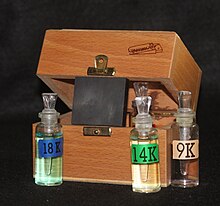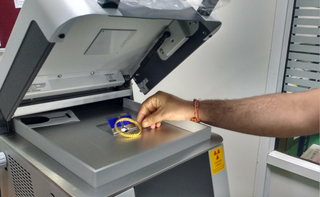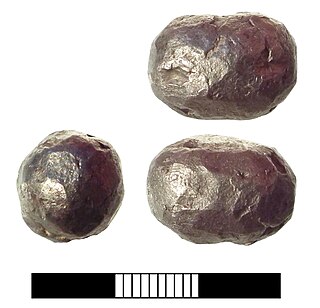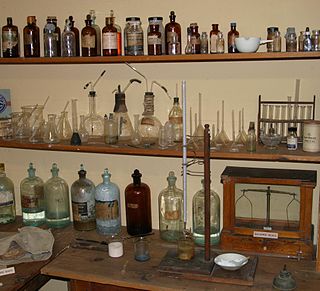
A touchstone is a small tablet of dark stone such as slate or lydite, used for assaying precious metal alloys. It has a finely grained surface on which soft metals leave a visible trace. [1]

A touchstone is a small tablet of dark stone such as slate or lydite, used for assaying precious metal alloys. It has a finely grained surface on which soft metals leave a visible trace. [1]
The touchstone was used during the Harappa period of the Indus Valley civilization ca. 2600–1900 BC for testing the purity of soft metals. [2] It was also used in Ancient Greece. [3]
The touchstone allowed anyone to easily and quickly determine the purity of a metal sample. This, in turn, led to the widespread adoption of gold as a standard of exchange. Although mixing gold with less expensive materials was common in coinage, using a touchstone one could easily determine the quantity of gold in the coin, and thereby calculate its intrinsic worth.
Drawing a line with gold on a touchstone will leave a visible trace. Because different alloys of gold have different colors (see gold), the unknown sample can be compared to samples of known purity. This method has been used since ancient times. In modern times, additional tests can be done. The trace will react in different ways to specific concentrations of nitric acid or aqua regia, thereby identifying the quality of the gold: 24 karat gold is not affected but 14 karat gold will show chemical activity.

An alloy is a mixture of chemical elements of which at least one is a metal. Unlike chemical compounds with metallic bases, an alloy will retain all the properties of a metal in the resulting material, such as electrical conductivity, ductility, opacity, and luster, but may have properties that differ from those of the pure metals, such as increased strength or hardness. In some cases, an alloy may reduce the overall cost of the material while preserving important properties. In other cases, the mixture imparts synergistic properties to the constituent metal elements such as corrosion resistance or mechanical strength.

Gold is a chemical element with the symbol Au and the atomic number 79. In its pure form, it is a bright, slightly orange-yellow, dense, soft, malleable, and ductile metal. Chemically, gold is a transition metal, a group 11 element, and one of the noble metals. It is one of the least reactive chemical elements, being the second-lowest in the reactivity series. It is solid under standard conditions.

Metallurgy is a domain of materials science and engineering that studies the physical and chemical behavior of metallic elements, their inter-metallic compounds, and their mixtures, which are known as alloys.

Electrum is a naturally occurring alloy of gold and silver, with trace amounts of copper and other metals. Its color ranges from pale to bright yellow, depending on the proportions of gold and silver. It has been produced artificially and is also known as "green gold".

Metalworking is the process of shaping and reshaping metals in order to create useful objects, parts, assemblies, and large scale structures. As a term, it covers a wide and diverse range of processes, skills, and tools for producing objects on every scale: from huge ships, buildings, and bridges, down to precise engine parts and delicate jewelry.

A goldsmith is a metalworker who specializes in working with gold and other precious metals. Nowadays they mainly specialize in jewelry-making but historically, goldsmiths have also made silverware, platters, goblets, decorative and serviceable utensils, and ceremonial or religious items.
A hallmark is an official mark or series of marks struck on items made of metal, mostly to certify the content of noble metals—such as platinum, gold, silver and in some nations, palladium. In a more general sense, the term hallmark can also be used to refer to any distinguishing mark.
The fineness of a precious metal object represents the weight of fine metal therein, in proportion to the total weight which includes alloying base metals and any impurities. Alloy metals are added to increase hardness and durability of coins and jewelry, alter colors, decrease the cost per weight, or avoid the cost of high-purity refinement. For example, copper is added to the precious metal silver to make a more durable alloy for use in coins, housewares and jewelry. Coin silver, which was used for making silver coins in the past, contains 90% silver and 10% copper, by mass. Sterling silver contains 92.5% silver and 7.5% of other metals, usually copper, by mass.

Gold plating is a method of depositing a thin layer of gold onto the surface of another metal, most often copper or silver, by chemical or electrochemical plating. Plating refers to modern coating methods, such as the ones used in the electronics industry, whereas gilding is the decorative covering of an object with gold, which typically involve more traditional methods and much larger objects.
This glossary of numismatics is a list of definitions of terms and concepts relevant to numismatics and coin collecting, as well as sub-fields and related disciplines, with concise explanations for the beginner or professional.

The term hardened steel is often used for a medium or high carbon steel that has been given heat treatment and then quenching followed by tempering. The quenching results in the formation of metastable martensite, the fraction of which is reduced to the desired amount during tempering. This is the most common state for finished articles such as tools and machine parts. In contrast, the same steel composition in annealed state is softer, as required for forming and machining.

The Karatmeter is a scientific instrument which uses X-rays to give an exact reading of the purity of gold. The Karatmeter is also referred to as a X-Ray fluorescence (XRF) spectrometer. Due to its very high precision and fast result, X-ray analysis has been adopted by international agencies in India as part of the certification process used to hallmark gold. It is an accurate, non-destructive means of testing the purity of gold and other related elements. Analyzing gold using XRF spectrometers gives the purity of gold, up to 10-12 microns and hence it gives the analysis of coating only.
Depletion gilding is a method for producing a layer of nearly pure gold on an object made of gold alloy by removing the other metals from its surface. It is sometimes referred to as a "surface enrichment" process.
Black Hills gold jewelry is a type of jewelry manufactured in the Black Hills of South Dakota. It was first created in the 1870s during the Black Hills Gold Rush by a French goldsmith named Henri LeBeau, who is said to have dreamed about the design after passing out from thirst and starvation. Black Hills gold jewelry depicts leaves, grape clusters and vines, and is made with alloys of gold with standard yellow gold as well as green and pink gold. In 1980, the 8th Circuit affirmed an injunction ruling that if a manufacturer was to call its jewelry Black Hills Gold, then it must be made in the Black Hills. The state of South Dakota designated Black Hills gold as the official state jewelry in 1988.

Colored gold is the name given to any gold that has been treated using techniques to change its natural color. Pure gold is slightly reddish yellow in color, but colored gold can come in a variety of different colors by alloying it with different elements.

Metals and metal working had been known to the people of modern Italy since the Bronze Age. By 53 BC, Rome had expanded to control an immense expanse of the Mediterranean. This included Italy and its islands, Spain, Macedonia, Africa, Asia Minor, Syria and Greece; by the end of the Emperor Trajan's reign, the Roman Empire had grown further to encompass parts of Britain, Egypt, all of modern Germany west of the Rhine, Dacia, Noricum, Judea, Armenia, Illyria, and Thrace. As the empire grew, so did its need for metals.
As a metaphor, a touchstone refers to any physical or intellectual measure by which the validity or merit of a concept can be tested. It is similar in use to an acid test, litmus test in politics, or, from a negative perspective, a shibboleth where the criterion is considered by some to be out-of-date. The word was introduced into literary criticism by Matthew Arnold in "Preface to the volume of 1853 poems" (1853) to denote short but distinctive passages, selected from the writings of the greatest poets, which he used to determine the relative value of passages or poems which are compared to them. Arnold proposed this method of evaluation as a corrective for what he called the "fallacious" estimates of poems according to their "historic" importance in the development of literature, or else according to their "personal" appeal to an individual critic.

A metallurgical assay is a compositional analysis of an ore, metal, or alloy, usually performed in order to test for purity or quality.
Gold parting is the separating of gold from silver. Gold and silver are often extracted from the same ores and are chemically similar and therefore difficult to separate. The alloy of gold and silver is called electrum.

A gold coin is a coin that is made mostly or entirely of gold. Most gold coins minted since 1800 are 90–92% gold (22‑karat), while most of today's gold bullion coins are pure gold, such as the Britannia, Canadian Maple Leaf, and American Buffalo. Alloyed gold coins, like the American Gold Eagle and South African Krugerrand, are typically 91.7% gold by weight, with the remainder being silver and copper.